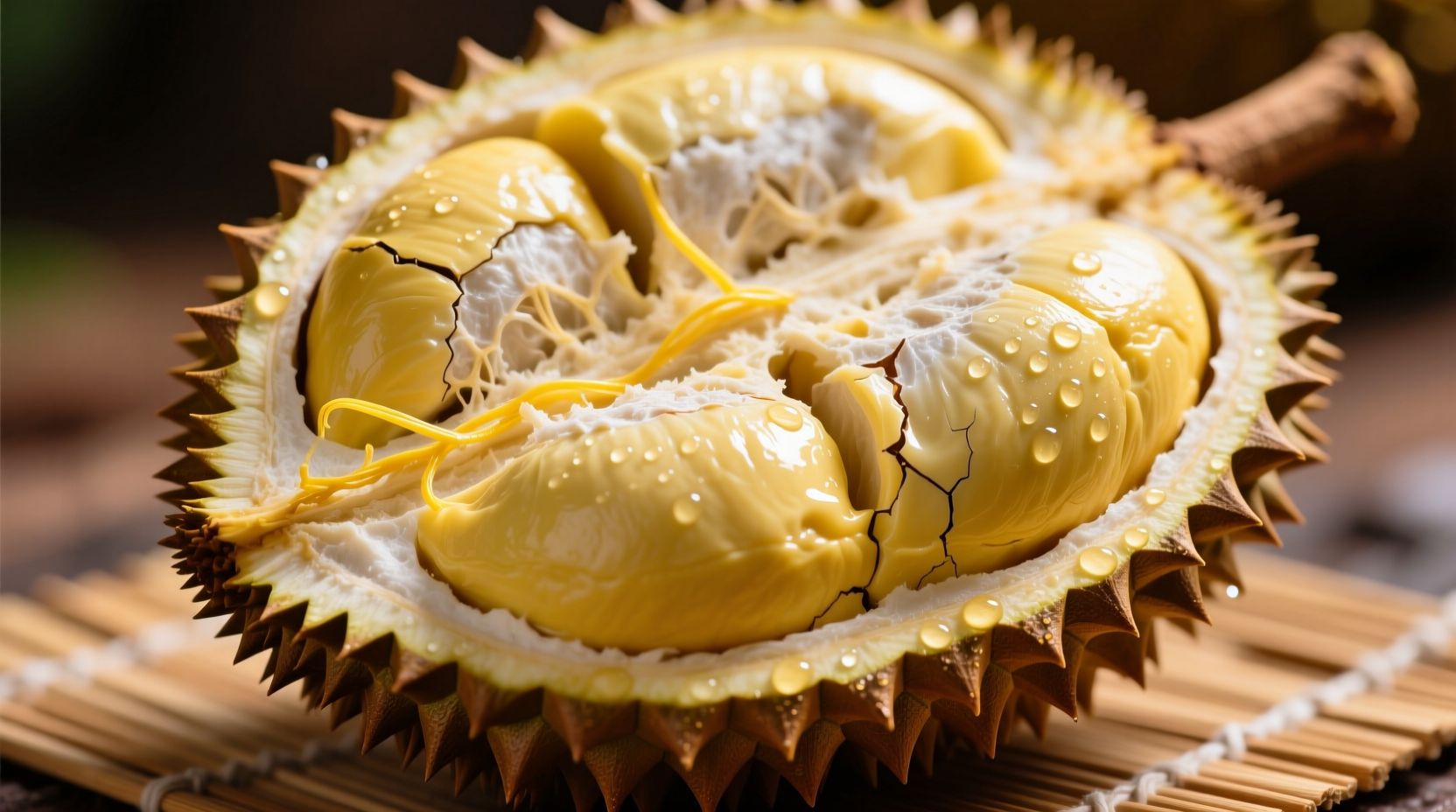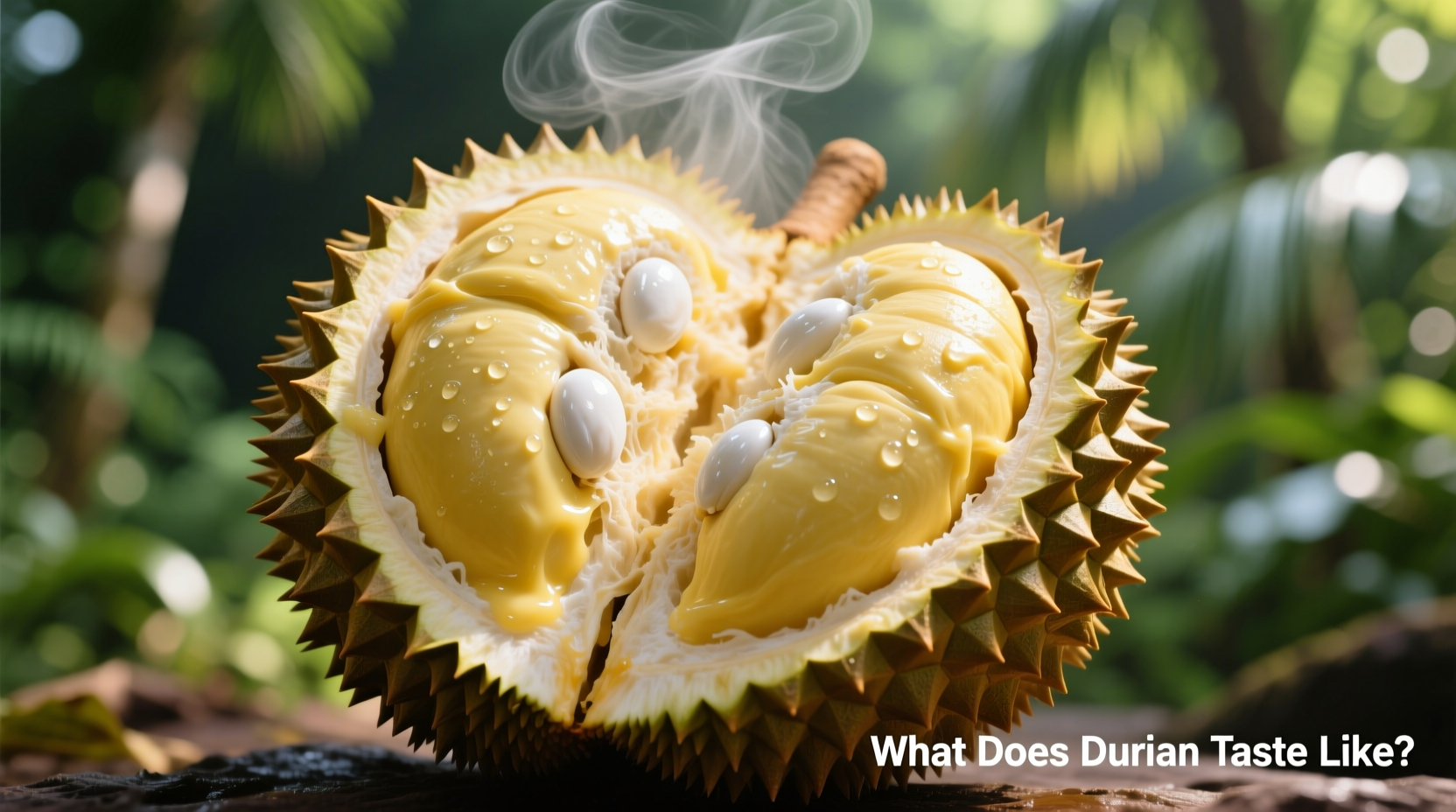Ever wondered why this "king of fruits" divides opinion like no other? Understanding durian's flavor profile isn't just about taste—it's a journey through cultural perception, chemical complexity, and sensory experience. Whether you're considering your first bite or trying to understand why others love (or hate) this spiky fruit, you'll discover exactly what to expect from durian's distinctive flavor, how ripeness transforms its taste, and why Southeast Asians cherish it despite its notorious reputation.
The Science Behind Durian's Signature Flavor
Durian's complex taste profile results from over 50 volatile compounds working in harmony. When perfectly ripe, the fruit develops high sugar content (approximately 27g per 100g) and significant fat (about 5g per 100g), creating its signature creamy texture. The controversial aroma primarily comes from sulfur-containing compounds similar to those found in onions and garlic, yet these transform into sweet, nutty flavors when the fruit reaches peak ripeness.
| Durian Variety | Flavor Profile | Sweetness Level | Texture |
|---|---|---|---|
| Musang King (D198) | Bitter-sweet with strong caramel notes | ★★★★☆ | Creamy, slightly fibrous |
| D24 (Sultan) | Mild sweetness with almond undertones | ★★★☆☆ | Smooth, buttery |
| Red Prawn (D176) | Intense sweetness with wine-like notes | ★★★★★ | Thick, custard-like |
| Monthong | Balanced sweet-bitter profile | ★★★☆☆ | Firm, less creamy |
Your First Bite: What to Actually Expect
When you take your first bite of durian, prepare for a multi-layered sensory experience. Initially, the strong aroma might overwhelm your senses, but as you taste it, you'll discover:
- The initial hit: A surprising sweetness reminiscent of crème brûlée or caramelized sugar
- Middle notes: Complex flavors emerge—think roasted almonds, vanilla, and hints of banana
- Finish: A subtle savory note similar to high-quality blue cheese lingers on the palate
Contrary to popular belief, durian isn't uniformly sweet. The best varieties balance sweetness with subtle bitter notes that create depth. This complexity explains why durian connoisseurs often describe it as having "umami" qualities—the fifth taste sensation that makes foods satisfyingly rich.
Why Durian's Reputation Doesn't Match Its Flavor
Research from the National University of Singapore reveals a fascinating disconnect between durian's smell and taste. The same sulfur compounds (like ethanethiol) that create its infamous odor transform during ripening into pleasant flavor compounds. What smells like rotten onions to some actually becomes sweet, complex flavors when tasted.
According to a 2023 cultural study published in the Journal of Sensory Studies, acceptance of durian follows a clear pattern:
- First-time tasters: 65% initially reject durian based on smell alone
- After tasting: 42% develop appreciation for the flavor despite the aroma
- Regular consumers: 89% describe durian as "irreplaceable" in their culinary experience

Timing Is Everything: When Durian Tastes Its Best
Durian's flavor transforms dramatically based on ripeness. Unlike most fruits, durian continues ripening after harvest, and its taste peaks during a narrow window. Understanding these stages prevents disappointing experiences:
- Underripe: Bland with rubbery texture and overwhelming bitterness
- Perfectly ripe: Complex sweet-creamy flavor with balanced aroma
- Overripe: Fermented notes develop, creating alcohol-like flavors some prefer
The ideal durian shows these characteristics:
- Slight give when gently pressed
- Stem appears dry and brown
- Natural split in the husk (not forced)
- Aroma is strong but not overwhelmingly sulfurous
Regional Perspectives: How Culture Shapes Durian Appreciation
Cultural context dramatically influences how people perceive durian's taste. In Thailand and Malaysia, where durian has been cultivated for centuries, children grow up developing their palates for its complex profile. The USDA Agricultural Research Service notes that regular exposure changes how our brains process durian's aroma compounds—what initially registers as "bad" eventually becomes associated with pleasurable eating experiences.
Interestingly, durian's banned in many public spaces across Southeast Asia not because locals dislike the smell, but precisely because they know how powerfully it lingers. This cultural paradox—cherishing a fruit while restricting its consumption in public—highlights how deeply durian is woven into regional identity.
Maximizing Your Durian Experience: Practical Tips
Whether you're a curious first-timer or looking to deepen your appreciation, these evidence-based techniques will transform your durian experience:
- Cool it slightly: Refrigerate for 15-20 minutes to mellow the aroma while preserving flavor
- Pair strategically: Try with sticky rice or coconut milk to balance intensity
- Start mild: Choose D24 variety for first experiences rather than stronger Musang King
- Temperature matters: Serve at 12-15°C (54-59°F) for optimal flavor release
Professional durian tasters recommend cleansing your palate with warm water between bites to fully appreciate each nuance. This technique, documented in traditional Malay tasting ceremonies, helps your taste buds reset and detect subtle flavor variations between segments.
Beyond the Hype: What Science Says About Durian's Flavor Complexity
Recent research from the Malaysian Agricultural Research and Development Institute confirms durian contains flavor compounds found in both sweet and savory foods. The fruit's unique profile includes:
- Diethyl disulfide (found in garlic) contributing savory depth
- Ethyl 2-methylbutanoate (common in fruits) providing sweet notes
- Acetoin (butter flavor compound) creating creamy mouthfeel
This chemical complexity explains why durian defies simple categorization as merely "sweet" or "savory." Instead, it engages multiple taste receptors simultaneously, creating an experience that evolves with each bite—a phenomenon food scientists call "flavor layering."











 浙公网安备
33010002000092号
浙公网安备
33010002000092号 浙B2-20120091-4
浙B2-20120091-4